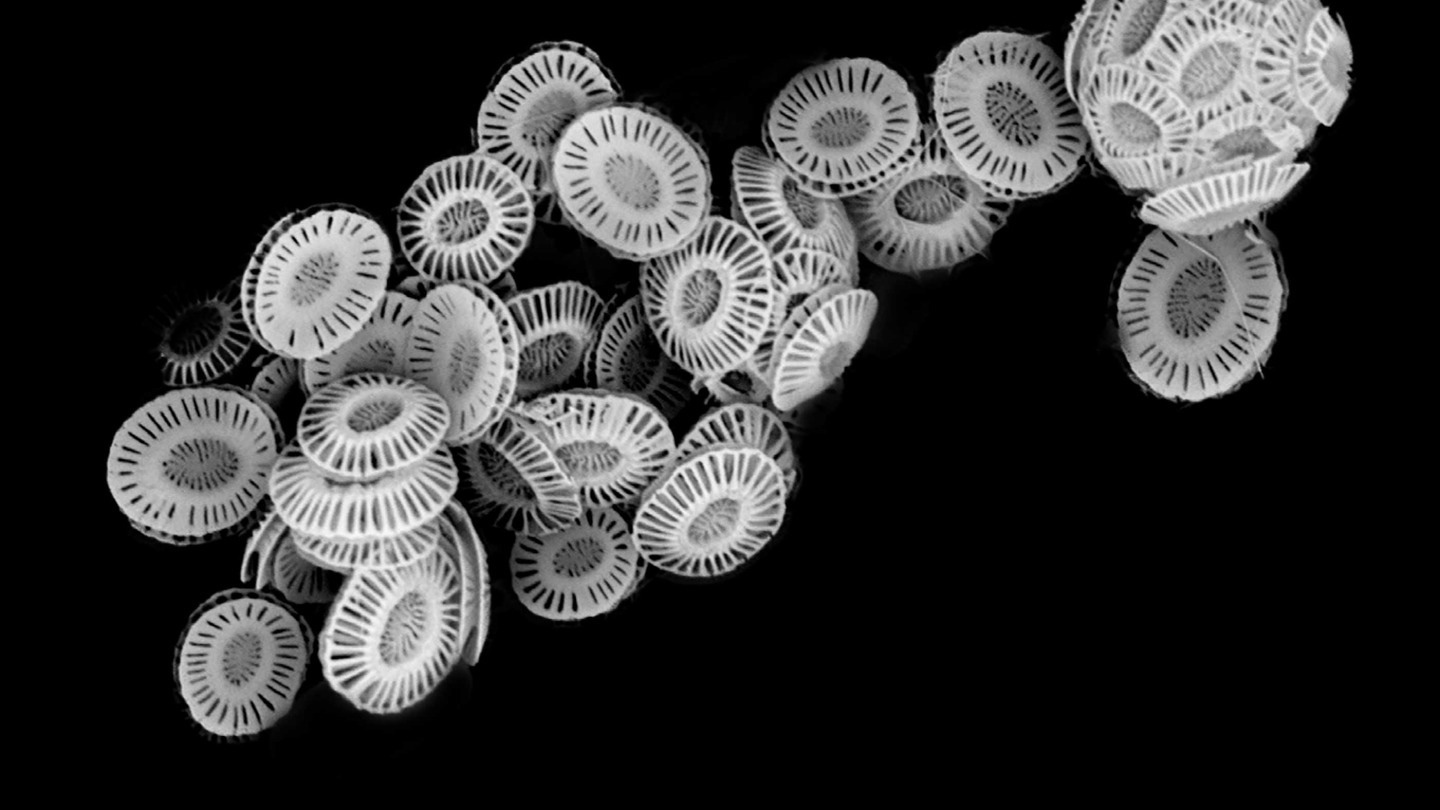Under the guidance of Rutgers University, a research group learning about virus-host interactions of worldwide abundant and armor-plated marine algae, Emiliania huxleyi, has discovered that the circular and chalk plates produced by the algae have the potential to serve as catalysts for viral infection.
 Scanning electron microscope image of the microscopic chalk disks called coccoliths formed by the marine algae Emiliania huxleyi. Image Credit: Courtesy of Bidle Lab.
Scanning electron microscope image of the microscopic chalk disks called coccoliths formed by the marine algae Emiliania huxleyi. Image Credit: Courtesy of Bidle Lab.
This consists of enormous impacts on trillions of microscopic oceanic creatures and the carbon cycle throughout the world.
In a drop of seawater, there will be about 1,000 to 10,000 E. huxleyi cells, and about 10 million viruses. They’re all in a sort of arms race against each other and we are studying it to see how it plays out and impacts Earth’s carbon cycle.”
Kay Bidle, Study Senior Author and Professor, Department of Marine and Coastal Sciences, School of Environmental and Biological Sciences, Rutgers University
Reporting in the journal Science Advances, the scientists stated that they found, via observations both in the ocean and in the laboratory, that the chalk (calcium carbonate) plates, known as coccoliths, are an earlier unidentified central player in viral infections that could crash phytoplankton blooms in the size of few countries within weeks.
“Coccoliths can act as catalysts for death, delivering viruses directly to algae cells for successful infection,” stated Christopher Johns, a doctoral student in the Department of Marine and Coastal Sciences at SEBS and lead author of the study.
E. huxleyi is known as a one-celled species of phytoplankton, which, similar to trees, performs photosynthesis. As far as phytoplankton is concerned, they transform carbon dioxide dissolved in ocean water into organic compounds and produce oxygen simultaneously.
The phytoplankton in the oceans contribute about half of Earth's oxygen, with the other half coming from land plants. Every other breath you take is from phytoplankton.”
Kay Bidle, Study Senior Author and Professor, Department of Marine and Coastal Sciences, School of Environmental and Biological Sciences, Rutgers University
E. huxleyi is popular for its potential to biomineralize calcium carbonate, just like corals, by generating coccoliths, which are organized on the cell surface to develop an armored layer. Such coccoliths are produced and further shed into the surrounding seawater in a continuous cycle.
According to Bidle the function of such coccoliths has been yet to be understood clearly for years. Scientists thought the chalk armor survived in part to safeguard phytoplankton from getting infected by viruses. Also, the leftover, free coccoliths were generally thought of as drifting planktonic particles passively with little ecological or biological roles.
However, in experiments performed in labs on the Cook campus at Rutgers University–New Brunswick, Johns, and other team members noted that the expelled coccoliths could determine their way back to the E. huxleyi cells, reattach, and simultaneously ferry viral particles, streamlining infection.
This potential to propagate and catalyze infection is one sudden role of the coccoliths with significant possible ecosystem outcomes.
Also, the breakthrough has a significant connection to climate change and the Earth’s carbon cycle, stated Bidle. Infected E. huxleyi cells tend to produce a sticky glue that could assist in aggregating particles into what is known as “marine snow.”
When marine snow is subjected to sinking into the deep ocean, it aids in burying and sequestering carbon, thereby eliminating it from the air for centuries to millennia. In this process, coccoliths are significant since they are bulkier compared to seawater and help make particles sink quicker and more rapidly into the deep ocean.
By helping in the death of the phytoplankton, and also in marine snow formation and sinking, the coccolith biominerals could eventually have a positive effect on the elimination of carbon dioxide from the upper ocean and atmosphere, stated Bidle.
This means the coccoliths facilitate the process of sequestering or sinking carbon into the deep ocean for thousands of years, making them important players in balancing the Earth’s carbon cycle.”
Kay Bidle, Study Senior Author and Professor, Department of Marine and Coastal Sciences, School of Environmental and Biological Sciences, Rutgers University
The other scientists from Rutgers include Associate Professor Heidi Fuchs; Karen Grace Bondoc-Naumovitz, a former postdoctoral fellow now at the University of Exeter in England; and Alexandra Matthews, a former undergraduate student, all within the Department of Marine and Coastal Sciences.
Also, scientists from the U.S. Department of Energy’s Oak Ridge National Laboratory, the University of California-Santa Barbara, and the University of North Carolina-Wilmington were involved in the study.